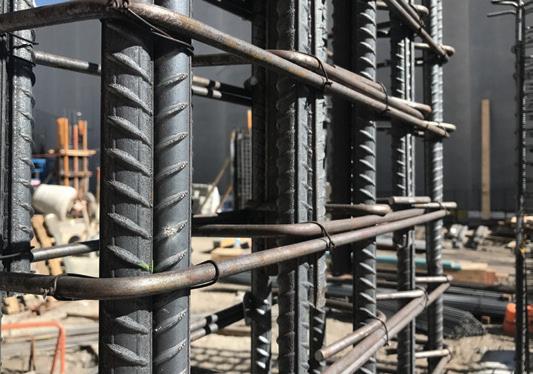
5 minute read
INCIDENT DATA PAVES WAY FOR CHANGE IN THE CRANE INDUSTRY
INCIDENT DATA PAVES WAY FOR
CHANGE IN THE CRANE
Advertisement
Until now, such data was considered too politically sensitive due to the complexity around determining root cause(s), legal liability, penalties, and outcomes. To overcome this issue and avoid interference with any ongoing investigations or reputational damage, the data has been de-identified and certain fields of information have been removed.
The information that remains is defined in broad categories and preliminary factual descriptions of equipment type, job type and incident type from which we can learn a surprising amount about what is really going wrong out there when an accident happens.
Worksafe Victoria has played a large part in not only unlocking the previous calendar year's data, but also securing the approval and paving the way for ongoing quarterly data instalments to be available to industry.
by John Humphries, VIC-TAS Safety Liaison Officer, The Crane Industry Council of Australia
The Crane Industry Council of Australia (CICA) and Worksafe Victoria have embarked upon a new collaboration involving the collection of raw incident data involving cranes and the construction industry dating back to January 2019, in an effort to increase site safety.
Two CICA Safety Bulletins have already been released focusing on topics that relate to the analysis and findings from this raw data and what these accumulating statistics point to. As time goes on, we will learn more and more about the nature of construction incidents involving cranes.
COLLECTING CRUCIAL DATA
This project follows the groundbreaking work of RMIT whose 2015 paper entitled Causes of Fatal Accidents Involving Cranes in the Australian Construction Industry studies a ten-year period from 2001-2013 during which 359 workers died in the Australian construction industry from work related causes. Of these, there are 258 ‘closed cases’ of which 22 involved a crane.
The work of RMIT focused on fatalities only, and as such, captured a limited number (22) cases that had run their course through our courts.

18 separate incidents that involved a crane in Q1-2020.
These incidents were also spread over a ten-year period, and during that time, equipment and technology have advanced immensely and standards/ best practices and training have evolved.
Where the RMIT paper proved immensely valuable, was the utilisation of the ‘Loughborough Model’ citing ‘immediate circumstances’, ‘shaping factors’, and ‘originating influences’, as well as specific details and breakdown of each incident, since this information was no longer legally suppressed.

INCIDENT DATA PAVES WAY FOR CHANGE IN THE CRANE INDUSTRY
But what if we could capture all incidents involving cranes as soon as they occur and still legally gather enough information to indicate relevant causal/contributing factors? The CICAWorksafe data initiative treads the fine line between obtaining vital information from ground-zero while not implicating workers, employers or equipment manufacturers.
IMPROVING SAFETY
If we are in the business of improving safety, what does that mean exactly? Less incidents per calendar year? Fewer fatalities per incident? Fewer injuries and resultant property damage when an incident occurs?
As much as we would like to say, “all of the above”, the complexity and variability of incident type, contributing factors and causal factors means there is no one solution that will fix everything and make everyone safe. We need a ’multi-pronged attack’ and where the data is useful is in the breakdown and classification of incidents. This grants us a better understanding of where extra attention, awareness and training is needed, it will best equip our pitchfork with the right prongs for attacking the crane incident ‘beast’.
Fortunately, with construction incidents involving cranes, we are dealing with less than 100 annually and we can scrutinise each case while staying within the bounds of confidentiality. We can see where minor and major injuries happen, as well as examining the ‘near miss’ and ‘dangerous occurrence’ cases.
Another dimension to the data is the fact that it exists for all construction incidents filterable by plant type. This means we can tap into the excavator and concrete data and search for similarities or differences in the electrical contact incidents to understand if their learnings can be applied to cranes.
We can assess other equipment with stabilising outriggers and understand the differences and similarities of ground

Types of incident (all crane types).
bearing, failure related tip overs. We can examine scaffolding and access incidents to understand falling from height incidents and the effectiveness of fall protection. Maybe the other industries are doing something ours is not, or vice versa.

JUST A START
In one sense, this data is in its infancy. We retrieved data from January 2019 and at the time of writing this, are only weeks away from receiving Q2 2020. However, the 100 incidents analysed to date have already shown us the most common crane types and incident groupings combined, with some clear opportunities for raising awareness and increased training. We have identified common circumstances for hand crush injuries, the dangers of unstable loads, falling objects and the benefits of keeping the lifting path clear.

84 incidents in 2019 that involved a crane.
Construction work is usually very physical and there is a significant human factor in most, if not all construction related incidents. This is not a statement of presumed liability or blame and as workers, we are subjected to many challenges that life throws at us every day whether it be emotional stress, depression, anxiety, illness, minor injury, fatigue or distraction. High risk work is just that, and the decisions workers must make throughout their day often have severe consequences.
We need to use this data to understand how to keep our worksites safe and to empower us to better understand the common and consistent causal factors and circumstances that lead to incidents, so they can be engineered out of our work methods and procedures. Although the incidents are reviewed individually to be classified and allocated causal and contributing factors, this data analysis project is a statistical global approach to the challenge of reducing construction incidents involving cranes. The power of complete and factual data is the best weapon we have when it comes to keeping us all safe on-site.
Falling object probable causal factors.
For more information on crane safety, sign up to the monthly CICA Crane Safety Bulletins by emailing










